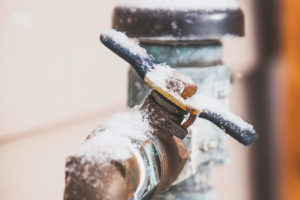Preventing Frozen Pipes
In cold weather, the potential for burst pipes is high. Frozen and burst pipes often result in extensive and costly property damage, which can, in turn, drive up the cost of our insurance program. Please have maintenance personnel check your facilities and take the following precautions to prevent property damage.

Preventive Maintenance
- Drain water from sprinkler supply lines following manufacturer’s or installer’s directions. Do not put antifreeze in these lines unless directed.
- Disconnect, remove and store outdoor hoses. Close all inside valves supplying outdoor hose bibs. Open the outside hose bibs to allow water to drain.
- Place an insulating dome or other covering on outdoor faucets and spigots.
- The Red Cross suggests installing specific products made to insulate water pipes like a “pipe sleeve” or installing UL-listed “heat tape,” “heat cable,” or similar materials on exposed water pipes.
- Inspect the area of the buildings were water supply lines are located in unheated areas, such as the basement, crawl spaces, garage, and under kitchen and bathroom cabinets. Be sure that all pipes in these areas are insulated.
- As a safety measure, keep a wrench stored near the valves and make sure designated personnel know how to shut off water valves if a pipe bursts.
- In unoccupied buildings, maintain heat at 55° Fahrenheit. Consider installing a low-temperature alarm to alert your property maintenance supervisor if the temperature inside a dwelling falls below 50° Fahrenheit.
When a Cold Spell Hits
When you know the temperatures will drop to exceptionally low levels, please take the following precautions:
- Set the thermostat to at least 68° F during extreme cold spells. Normally 55° F is sufficient, but during an extreme cold spell it is prudent to set the thermostat higher.
- Inspect the area around the pipes for any air leaks and seal leaks.
- Check the heating systems to ensure proper functioning.
- Check all faucets. Make sure water flows freely and no leaks are present. If you turn on a faucet and only a trickle comes out, this may be a sign of a frozen pipe.
- During deep freezes, the Federal Alliance for Homes recommends allowing a slow drip from your faucets to reduce the buildup of pressure in the pipes. Even if the pipes freeze, the release pressure in the water system will reduce the likelihood of a rupture.
- Open kitchen and bathroom cabinet doors to allow warmer air to circulate around the plumbing.
- Be sure designated staff members know the location of all shut off valves; in the event a pipe bursts, you will need to stop the flow of water as soon as possible.
- If possible, schedule a maintenance check in the evening to be sure heating is functioning properly.
- For less frequented areas and unoccupied buildings, have custodial staff check heating andfaucets two to three times a day to ensure there is no indication of frozen pipes. This is important as discovering a frozen line (no water flow) prior to the pipe thawing permits the opportunity to shut off the water before it leaks and may also provide an opportunity to thaw the pipe before the ice expands enough to split the pipe or fitting.
Treating Frozen Pipes
- If you open a faucet and little to no water comes out, leave the faucet open, turn off the water at the main shut-off valve, and call a plumber.
- Never attempt to thaw a frozen pipe with an open flame. You may be able to thaw a frozen pipe with the warm air from a hair dryer. Start by warming the pipe closet to the faucet, working toward the coldest section of the pipe.
- If a water pipe bursts, completely open all faucets and turn off the water at the main shut-off valve. Call a plumber immediately.

